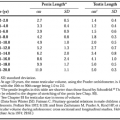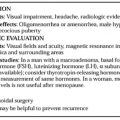STANDARD INITIAL OPERATIVE MANAGEMENT
Under general anesthesia, the patient is positioned supine with arms at the sides and the neck extended to maximally expose the anterior cervical region. A curvilinear incision is made low in the neck and extended through the platysma muscle. The strap muscles are separated in the midline to expose the underlying thyroid gland. After mobilization and medial retraction of the respective thyroid lobe, the recurrent laryngeal nerve and inferior thyroid artery are identified, and the search for the parathyroid glands begins.
The goal of the initial neck exploration for hyperparathyroidism is first to identify all four parathyroid glands and then to remove those that are enlarged. This requires exploration of both sides of the neck to identify all parathyroid glands. Stopping the exploration after finding one normal gland and one abnormal gland on one side of the neck leads to an increased incidence of missed tumors.1 The size of the parathyroid gland should be the factor that determines resection, because the pathologists’ interpretations of “adenoma” or “hyperplasia” are misleading. In most patients, only one parathyroid gland is enlarged. The large parathyroid glands should be excised, and the normal-appearing parathyroid glands should be left in situ. The surgical decision should not be based only on the histologic interpretation. In addition, tests of gland density (water immersion test) and histochemical staining for cytoplasmic lipid content are unreliable indicators of parathyroid gland behavior.
In most patients with single-gland disease, removal of the enlarged parathyroid gland is curative.2 Infrequently, patients
with hyperparathyroidism harbor two or three enlarged parathyroid glands, all of which should be removed. In one study, 76 patients with hyperparathyroidism caused by two or three enlarged parathyroid glands were evaluated from 12 to 140 months after resection of only the large parathyroids.3 Persistent or recurrent postoperative hypercalcemia developed in eight patients (10.5%) from 1 to 133 months postoperatively. Thus, these patients appear to have an increased incidence of persistent or recurrent hypercalcemia compared with patients with hyperparathyroidism caused by single-gland disease.
with hyperparathyroidism harbor two or three enlarged parathyroid glands, all of which should be removed. In one study, 76 patients with hyperparathyroidism caused by two or three enlarged parathyroid glands were evaluated from 12 to 140 months after resection of only the large parathyroids.3 Persistent or recurrent postoperative hypercalcemia developed in eight patients (10.5%) from 1 to 133 months postoperatively. Thus, these patients appear to have an increased incidence of persistent or recurrent hypercalcemia compared with patients with hyperparathyroidism caused by single-gland disease.
Stay updated, free articles. Join our Telegram channel

Full access? Get Clinical Tree






